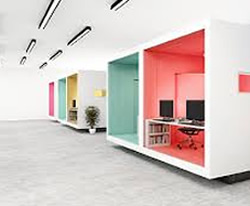Jane Margolies* says the pandemic may result in fundamental changes to our workplaces, altering how office buildings are designed.
 Many workers are weeks, if not months, from returning to their offices and regaining a semblance of a normal workday.
Many workers are weeks, if not months, from returning to their offices and regaining a semblance of a normal workday.
But building owners and employers have begun to anticipate the time when the COVID-19 orders are lifted and people start heading back to the office.
The post-pandemic office might look radically different.
Returning workers can expect stepped-up cleaning and a reinforcement of social distancing.
Hand sanitiser stands will probably be positioned in lobbies.
Maintenance staff will swab door handles.
There may be limits on the number of people allowed in an elevator.
Workplaces may have significant changes in the long run, including new seating arrangements and the addition of building materials that discourage the spread of germs.
New technology could provide access to rooms and elevators without employees having to touch a handle or press a button.
Even if such changes won’t greet most employees at first, their return to the office may be carefully choreographed.
In the short term, signs may be posted reminding everyone to wash hands — and perhaps stick with elbow bumps rather than handshakes and hugs.
Disinfectant wipes will be everywhere.
Some employers are considering phasing in employees to limit the number of people on the premises.
Remote-work practices that many have adopted in recent weeks are likely to continue in some form for the foreseeable future, leaving some offices lightly populated and making it easier for workers to spread out.
Alternating groups of employees at the office is also under discussion.
“There could be A teams and B teams working different days,” said Scott Rechler, the CEO of RXR Realty.
Moving desks farther apart could also give workers more elbow room.
Over the past decade, many employers eliminated private offices in favour of open plans, but the amount of space per office worker declined 25 per cent.
Benching — desks lined up side by side — has been another way workers have been squeezed.
To create a 2m radius around each employee, organisations may have to pull desks apart or stagger employees so they are not facing one another, experts say.
A conference room intended for 12 might be repurposed as a meeting room for six.
In lounge areas, chairs could be placed farther apart.
“The whole point of kinetic furniture was to bring people together,” said Kelly Griffin, a principal at architecture firm NBBJ.
“Now it has a different function: to pull people apart.”
So-called hot-desking, or hoteling — where employees do not have designated desks but instead come in and find a place to sit — may go on hiatus, if only until the fear of contagion fades.
However, the pandemic may result in fundamental changes that will be around for years to come, altering how office buildings are designed.
The coronavirus may focus attention on air circulation and filtering.
Sensor-activated controls may also increase, reducing the number of surfaces that need to be touched in an office and allowing workers to use elevators and open doors with the wave of a hand.
Smooth surfaces that are easy to wipe will be preferable to textured or porous ones that could harbour germs.
And antimicrobial materials used in hospitals and laboratories may migrate to offices.
Interest has surged in new materials such as those that mimic sharkskin, to which microscopic organisms have difficulty adhering.
Some old metals may experience a revival.
Copper and its alloys — including brass and bronze — have been shown to be essentially self-sanitising, able to kill bacteria and, early studies suggest, perhaps even the coronavirus plaguing the planet.
The ability to work from home at least a few days a week — long sought by many — may be here to stay.
Even firms that previously insisted on everyone’s being in the office have discovered that the work-from-home experiment that the crisis has thrust on large parts of the workforce has turned out better than expected.
Kate Lister, President of Global Workplace Analytics, expects more than 25 per cent of employees to continue working from home multiple days a week, up from fewer than 4 per cent who did so before the pandemic.
“I don’t think that genie is going back into the bottle,” she said.
Already preliminary findings from a new study by researchers at the Massachusetts Institute of Technology (MIT) suggest that more than 34 per cent of respondents have switched from commuting to working at home.
The digital infrastructure for remote work already existed, said Erik Brynjolfsson, Director of the MIT Initiative on the Digital Economy and a co-author of the study.
“The tools people found are working pretty well,” he said.
If organisations do allow more of their employees to log in from home, some may consider reducing their office footprint, which could have significant ramifications for commercial real estate.
But if the amount of space devoted to employee workstations and other functions increases, demand for space could balance out.
Lounges, cafes and other gathering spaces that sprang up to make collaborative work easier may become even more important if employees do more work from home and commute in for meetings.
At the Seattle office of B+H Architects, an informal space called the Sandbox was designed as “a place to meet and exchange ideas,” said Doug Demers, a managing principal at the firm.
The circular room has a large digital screen for sharing information and curved seating that provides a sense of enclosure.
People working from home could call in remotely, Mr Demers said, but he thinks this kind of space will be one of the things that draws employees back to the office because it helps provide a sense of community.
“There will be a higher value around spaces where we come together,” he said.
* Jane Margolies is a frequent contributor to The New York Times and Contributing Editor to Landscape Architecture Magazine. She tweets at @janemargolies.
This article first appeared at www.nytimes.com.











